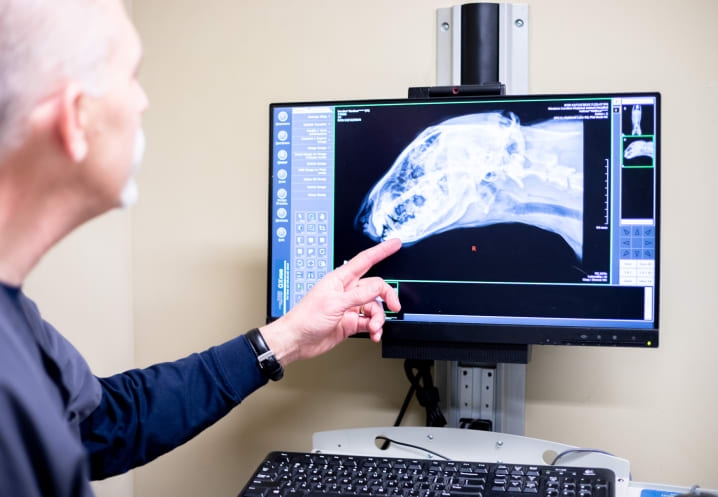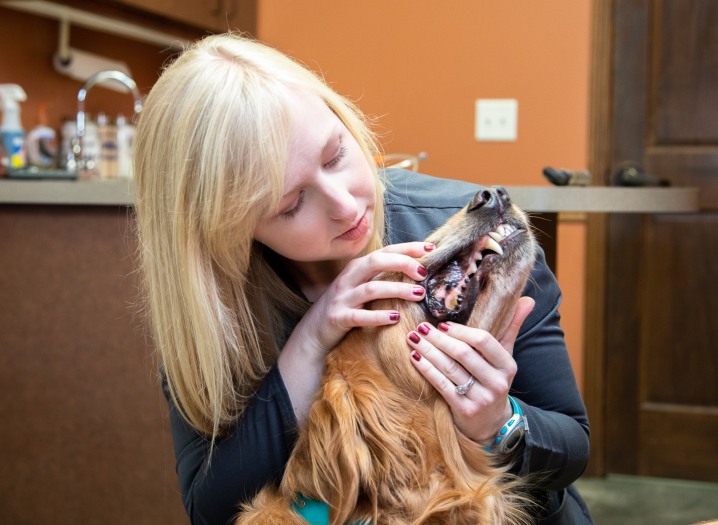Quality Pet Dental Care
At Western Carolina Regional Animal Hospital & Veterinary Emergency Hospital, our vets provide the highest level of dental and oral care for pets in Flat Rock.
What is dentistry for pets?
Veterinary dentistry encompasses the cleaning, repair, adjustment, extraction, or filling of your pet's teeth, as well as oral healthcare.
Cats or dogs can develop dental problems related to a range of other health problems. Without regular cleaning, pets are also at risk for periodontal (gum) disease.
Your veterinarian is a critical ally in your pet's dental health. Regular (annual) dental cleanings will allow the vet to diagnose early signs of an issue and treat it to prevent it from becoming serious.


Preventive Dental Care For Cats & Dogs
It's essential that your pet visit a veterinarian for an annual oral health checkup.
Your vet will start the exam by inspecting your pet's mouth. Your vet may need to take x-rays to evaluate the health of your pet's mouth and roots of the teeth.
Since most dental diseases in animals are invisible because they occur below the gum line, your pet must be put under anesthesia so a thorough dental cleaning and evaluation can be completed.
Similar to the dental cleaning process at your own dentist's office, this dental cleaning will also include scaling to get rid of dental plaque and tartar.
Symptoms of Dental Problems
Common symptoms of dental problems include:
- Loose or broken teeth
- Bleeding from the mouth
- Pain or swelling in or around the mouth
- Reduced appetite or refusal to eat
- Abnormal chewing, drooling, or dropping food from the mouth
- Teeth with discoloration or tartar buildup
- Extra teeth or retained baby teeth
FAQs about Dentistry & Dental Surgery
Below you can find some of the most commonly asked questions we receive about dentistry for pets.
ASK A DIFFERENT QUESTION
- How is the dental care treatment at Western Carolina Regional Animal Hospital and Veterinary Emergency Hospital different?
Our goal is always to provide a calm, relaxed experience for you and your pet. We've got soft, cushy chairs for your pet to get comfy on! Our modern dental surgery suite looks similar to a dental office that you'd take your family to.
Much of our equipment is similar to what you'd find at a human dental office, including leading anesthesia monitoring and delivery equipment, digital dental radiography units, and high-speed dental units.
Book An Appointment - What is the difference between periodontal disease and gingivitis?
Periodontal (gum) disease attacks the supporting tissues around teeth, and is the main cause of early tooth loss.
This progressive disease starts when bacteria fuses with food particles to form plaque on the teeth. Within days, minerals in your pet's saliva combine with the plaque to form tartar, a hard substance that sticks to the teeth.
The bacteria then work their way beneath the gums to cause inflammation of the gums - gingivitis.
Gingivitis and periodontitis comprise the changes that are known as periodontal disease. The bacteria associated with periodontal disease can also migrate through the bloodstream to infect the liver, kidneys, and heart.
- What is the risk of my pet developing periodontal disease?
Some estimate that by the time they are 3 years old, 85 percent of all pets have some level of periodontal disease.
- What's involved in a dental cleaning for my cat or dog?
A dental cleaning may include these steps:
- Inspection of the tongue, lips, and entire mouth for wounds, growths, or other problems
- Removal of visible plaque and tartar from the teeth
- Probing of dental sockets to assess dental disease
- Elimination of plaque and tartar from under the gum
- Dental radiographs (x-rays) to identify problems below the gum line
- Removal or repair of infected or fractured teeth
- Polishing to smooth enamel scratches that may attract bacteria
- Application of fluoride or a dental sealer
- Dental charting so progression of dental disease can be monitored
- What can I do at home to keep my pet's teeth clean?
Once your pet's dental cleaning has been completed, you can take several measures at home to keep your pet's teeth sparkling.
Your vet may suggest a plaque prevention product —a substance that you'll apply to your pet's teeth and gums each week. This product sticks to to the tooth surface to create a barrier that keeps plaque from developing.
Just as with people, daily brushing helps to eliminate food particles from between your pet's teeth. You can use a child's toothbrush or buy a finger brush from your veterinarian.
Certain treats and diets can also help reduce plaque and tartar. These diets tend to have larger kibbles to provide abrasive action against the tooth surface when chewed, or may include ingredients that help prevent tartar mineralization.
- Does my pet need to be put under anesthesia?
Western Carolina Regional Animal Hospital & Veterinary Emergency Hospital's progressive dentistry and oral surgery center provides compassionate oral care for your pet.
When you visit the dentist, you're aware of what's being done and that it's intended to help you and keep your mouth healthy. The dentist uses techniques to ensure you feel as little pain and discomfort as possible and asks you how you are feeling, so you accept the procedures and do your best to keep still.
But, your pet does not understand any of this – and he or she reacts by biting, moving, or attempting to escape.We use anesthesia to complete dental procedures with less stress and pain for your pet. Additionally, if digital radiographs (x-rays) are required, your pet must be very still in order to capture good images. Sedation or anesthesia helps with this.
- What are the risks with anaethesia?
Although anesthesia will always carry risks, it's now safer than ever and continues to improve. The benefits far outweigh the risks, which are very low.
Most pets can go home on the day of the procedure, although they might seem a little drowsy for the remainder of the day.
